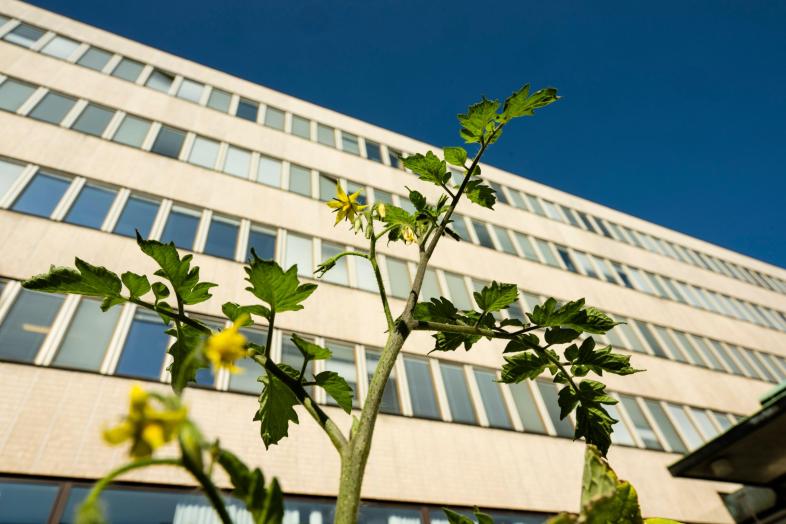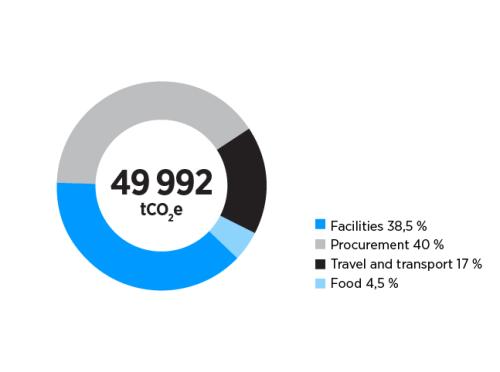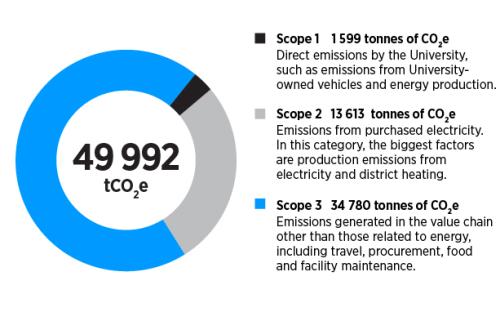Concrete climate action required from the University now and in the future

In 2023 work on the objectives set out in the Carbon neutral University of Helsinki 2030 roadmap mainly progressed as planned, and we succeeded in reducing our carbon footprint from 2022. However, much remains to be done to reduce our impact on the climate.
The reduction of the carbon footprint is our primary goal. In 2023 the University’s carbon footprint was 49,992 tCO₂e, which means it began to fall as planned.
“The method for calculating the footprint is defined annually in detail and actively developed. However, at the end of the day it’s simply a tool for monitoring progress. We must focus on tangible action to reduce emissions,” says Pekka Joensuu, who is responsible for calculating the University’s carbon footprint.

Emissions were successfully reduced particularly in facilities, the area accounting for a large share of the University’s carbon footprint, 38.5 percent. Other emissions sources were procurement (40 percent of total emissions), and travel and transport (17 percent). Food accounted for 4,5 percent of total emissions.

Only carbon-neutral electricity bought in 2023
In 2023 all the electricity purchased by the University was carbon neutral, as we bought guarantees of origin for nuclear power. The renewable energy produced on campuses accounted for 2.5 percent of all energy consumed.
The amount of waste produced in facilities regrettably increased by 5 percent from the previous year. The recycling rate was 56 percent. The goal for 2030 is that all purchased electricity and district heating in our facilities will be carbon neutral, while 10 percent of our energy consumption will be covered by independently produced renewable energy. At the same time, fossil heating fuels will be abandoned. We are unable to influence the goal of carbon neutrality for district heating, as we depend on the energy company Helen and its operational targets.
In 2024 we will draft instructions for low-carbon construction and increase the number of containers for sorting waste.
New guidelines encourage staff to travel more sustainably
In 2023 we prepared new travel guidelines. Monitoring compliance with them in the coming years will show us how the guidelines affect travel emissions. We will examine both commuting and work-related travel, whose greatest respective sources of emissions are private car usage and air travel.
In the next few years, we will develop bicycle parking on the campuses and seek other ways to reduce travel and transport emissions.
Making a difference through concrete solutions and market dialogue
In procurement, we successfully used tendering to reach our goal of prioritising suppliers committed to low-carbon activities. However, we do not yet have access to comprehensive information on the production chains of all the goods and services we purchase.
Our goals are to track reliably the carbon footprint of purchased goods and services, introduce efficient recycling and circular economy models, and nurture a strong culture of shared use. We will invest increasingly in these goals in the coming years by developing market dialogue and internal circular economy models.
Our cafeteria operators have made efforts to reduce the carbon footprint of lunches and catering and to offer sustainable options. At UniCafe cafeterias, for example, vegan and vegetarian options accounted for 48 percent of all lunches sold in 2023, vegan options are always cheaper than non-vegan ones, and plant-based alternatives are placed first on the counter.
Most food emissions are generated by the lunch cafeterias operating on our premises, and we are expecting them to prepare transparent low-carbon and sustainability programmes. In 2023 we issued the University’s new catering recommendations to help support the measures outlined in the Carbon neutral University of Helsinki by 2030 roadmap (pdf). These measures aim to ensure that the University’s catering services prioritise plant-based food by 2030.
We will engage in more active market dialogue with cafeteria operators and will integrate sustainability goals more closely into their competitive tendering.
How to progress towards 2030?
To promote the University’s goal of carbon neutrality, we published in spring 2023 the Carbon-neutral University of Helsinki 2030 roadmap (pdf), with emissions reduction goals for the four areas with the highest emissions. These areas are facilities, procurement, travel and transport, and food.
“We now have guidelines for emissions reduction goals, but are all responsible for achieving them. I would like to see the administrative sectors consider in detail what each of us can do to help us reach our goals,” says Vice-Rector Anne Portaankorva.
Progress on the goals will be actively monitored and they will be compared with the annually calculated carbon footprint. Active monitoring will help us identify both successes and areas requiring additional efforts.
“At present, reducing emissions is our primary target. However, we will also examine broader developments in climate work, taking into account the significance of biodiversity efforts and the steps taken to offset emissions. We are also monitoring actively how the regulations being prepared in the EU affect companies and organisations in defining responsibility goals and offsetting climate emissions,” notes Senior Specialist in Sustainability and Responsibility Riina Koivuranta.
Method of carbon footprint calculation
A carbon footprint is calculated in accordance with the Greenhouse Gas Protocol (GHG). The University of Helsinki takes into account not just direct emissions (Scope 1) and emissions from bought energy (Scope 2), but also indirect emissions (Scope 3), such as travel and procurement.

Thoughts, comments, questions? Discuss this news item in Flamma.
Main photo: Veikko Somerpuro